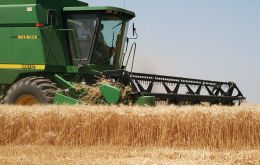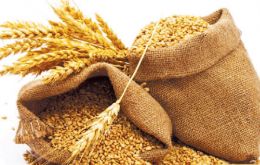MercoPress. South Atlantic News Agency
Tag: wheat production
-
Friday, January 13th 2017 - 12:37 UTC
Brazil retakes wheat imports, the highest in three years

Brazilian officials ditched expectations of a tumble in wheat imports to a multi-year low after a surprisingly strong finish to 2016 for buy-ins, encouraged by a recovery in the real and state purchases of domestic supplies. Conab - which a month ago slashed its forecast for Brazil's wheat imports in 2016-17 [on an August-to-July basis] to 5.10m tonnes, the lowest since at least the mid-1990s – this week revised its forecast sharply upwards, to 5.95m tonnes.
-
Monday, June 20th 2016 - 08:41 UTC
Argentina estimates more corn and less soybeans for 2016/17

Argentina's Agro-industry minister Ricardo Buryaile estimated the 2016/17 corn crop should reach 52.9 million tons, given a 20% increase in the area planted, which will be in detriment of soybeans. The last crop of corn, 2015/16, was 37.9 million dollars.
-
Wednesday, May 18th 2016 - 12:07 UTC
Argentina forecasted to increase wheat area by 25% for a 15/16 million tons crop

Argentine wheat exports more than doubled in the first quarter, government data showed, as farmers rushed to sell stockpiles ahead of an expected jump in plantings spurred by the open-market policies of new President Mauricio Macri. The surge in Argentine supply is hitting an oversaturated world market and putting downward pressure on wheat prices already near their lowest levels in six years.
-
Friday, April 8th 2016 - 06:58 UTC
Large inventories and sluggish demand for 2016/17 global cereal production predicts FAO

World cereal production in 2016 is set to amount to 2 521 million tons, just 0.2% off last year's large output and the third-highest global performance on record, according to FAO's first forecast for the new season, released on Thursday. Large inventory levels and relatively sluggish global demand mean that market conditions for staple food grains appear stable for at least another season, the agency's latest Cereal Supply and Demand Brief predicts.
-
Friday, March 18th 2016 - 05:55 UTC
Strong 2016 wheat harvests seen in China and South Asia

FAO's latest Cereal Supply and Demand Brief forecasts a 1.4 percent drop in worldwide wheat output in 2016, due mainly to dry weather leading to reduced winter plantings in the Russian Federation and Ukraine. However, China and Pakistan are expected to sustain near-record wheat harvests, and India's output is anticipated to recover.
-
Saturday, November 21st 2015 - 08:09 UTC
High expectations in Argentina of a record soybean sowing in 2015/16

Argentina's much-watched soybean sowings will set a record this season, but the country is heading for a weaker wheat harvest, despite ideas of “very good” yields, the country's farm ministry said. In its first estimate the ministry said soybean sowings for 2015-16, pegged area at 20.6m hectares, a rise of 800,000 hectares year on year.
-
Tuesday, November 10th 2015 - 06:33 UTC
FAO food commodity prices rose in October 3.9%, but 16% down from a year earlier

The FAO Food Price Index averaged nearly 162 points in October, up 3.9% from September, while still down 16% from a year earlier. FAO's latest Cereal supply and Demand Brief slightly trimmed its October 2015 forecast for global cereal production and now projects production at 2.53 billion tons, 1.1% below last year's record output
-
Thursday, May 7th 2015 - 05:22 UTC
US for third year running main wheat supplier for Brazil displacing Argentina

For a third year in a row the United States will be the top wheat supplier for Brazil, displacing Argentina from its historic position, according to the latest release from Brazilian consultancy Trigo & Farinhas. This piece of information is significant given the world prices for grains and wheat planting prospects in South America.
-
Monday, September 29th 2014 - 09:09 UTC
Record soybean and wheat crops forecasted by the International Grains Council

The 2014-2015 season’s soybean and wheat crops are on track to set records, while rice and corn look poised to be more in line with last season’s record crops, according to the International Grains Council's September Grain Market Report.
-
Saturday, September 13th 2014 - 07:11 UTC
World cereal production forecasted to be a record in 2014, according to FAO

FAO's Food Price Index is a trade-weighted index that measures prices of five major food commodities on international markets: in addition to sub-indices for prices of cereals, it also tracks meat, dairy products, vegetable oils, and sugar.
